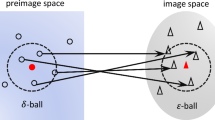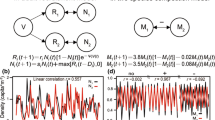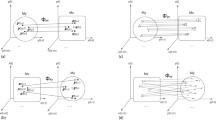Abstract
Natural systems are typically nonlinear and complex, and it is of great interest to be able to reconstruct a system in order to understand its mechanism, which cannot only recover nonlinear behaviors but also predict future dynamics. Due to the advances of modern technology, big data becomes increasingly accessible and consequently the problem of reconstructing systems from measured data or time series plays a central role in many scientic disciplines. In recent decades, nonlinear methods rooted in state space reconstruction have been developed, and they do not assume any model equations but can recover the dynamics purely from the measured time series data. In this review, the development of state space reconstruction techniques will be introduced and the recent advances in systems prediction and causality inference using state space reconstruction will be presented. Particularly, the cutting-edge method to deal with short-term time series data will be focused on. Finally, the advantages as well as the remaining problems in this field are discussed.
Similar content being viewed by others
References
Ancona N, Marinazzo D, Stramaglia S. Radial basis function approach to nonlinear Granger causality of time series. Phys Rev E (3), 2004, 70: 056221
Ansari-Asl K, Senhadji L, Bellanger J J, et al. Quantitative evaluation of linear and nonlinear methods characterizing interdependencies between brain signals. Phys Rev E (3), 2006, 74: 031916
Arnhold J, Grassberger P, Lehnertz K, et al. A robust method for detecting interdependences: Application to intracranially recorded EEG. Phys D, 1999, 134: 419–430
Blinowska K J, Kuś R, Kamiński M. Granger causality and information flow in multivariate processes. Phys Rev E (3), 2004, 70: 050902
Boyce M S. Population viability analysis. Annu Rev Ecol Syst, 1992, 23: 481–497
Breakspear M, Terry J. Detection and description of non-linear interdependence in normal multichannel human EEG data. Clin Neurophysiol, 2002, 113: 735–753
Brovelli A, Ding M, Ledberg A, et al. Beta oscillations in a large-scale sensorimotor cortical network: Directional influences revealed by Granger causality. Proc Natl Acad Sci USA, 2004, 101: 9849–9854
Buzug T, Pster G. Optimal delay time and embedding dimension for delay-time coordinates by analysis of the global static and local dynamical behavior of strange attractors. Phys Rev A (3), 1992, 45: 7073–7084
Candes E J, Romberg J K, Tao T. Stable signal recovery from incomplete and inaccurate measurements. Comm Pure Appl Math, 2006, 59: 1207–1223
Casdagli M. Nonlinear prediction of chaotic time series. Phys D, 1989, 35: 335–356
Casdagli M, Eubank S, Farmer J D, et al. State space reconstruction in the presence of noise. Phys D, 1991, 51: 52–98
Chen L, Liu R, Liu Z, et al. Detecting early-warning signals for sudden deterioration of complex diseases by dynamical network biomarkers. Sci Rep, 2012, 2: 342
David O, Guillemain I, Saillet S, et al. Identifying neural drivers with functional MRI: An electrophysiological validation. PLoS Biol, 2008, 6: e315
de Jong H. Modeling and simulation of genetic regulatory systems: A literature review. J Comput Biol, 2002, 9: 67–103
Deyle E R, Fogarty M, Hsieh C H, et al. Predicting climate effects on Pacic sardine. Proc Natl Acad Sci USA, 2013, 110: 6430–6435
Deyle E R, Maher M C, Hernandez R D, et al. Global environmental drivers of in uenza. Proc Natl Acad Sci USA, 2016, 113: 13081–13086
Deyle E R, Sugihara G. Generalized theorems for nonlinear state space reconstruction. PLoS ONE, 2011, 6: e18295
Fan J, Han F, Liu H. Challenges of big data analysis. Natl Sci Rev, 2014, 1: 293–314
Farmer J, Sidorowich J. Predicting chaotic time series. Phys Rev Lett, 1987, 59: 845–848
Finkenstädt B, Kuhbier P. Forecasting nonlinear economic time series: A simple test to accompany the nearest neighbor approach. Empir Econ, 1995, 20: 243–263
Fraser A M, Swinney H L. Independent coordinates for strange attractors from mutual information. Phys Rev A (3), 1986, 33: 1134
Geweke J. Inference and causality in economic time series models. In: Handbook of Econometrics, vol. 2. Amsterdam: Elsevier, 1984, 1101–1144
Granger C. Investigating causal relations by econometric models and cross-spectral methods. Econometrica, 1969, 37: 424–438
Granger C. Time series analysis, cointegration, and applications. Amer Econ Rev, 2004, 94: 421–425
Grassberger P, Procaccia I. Measuring the strangeness of strange attractors. Phys D, 1983, 9: 189–208
Grassberger P, Schreiber T, Schaffrath C. Nonlinear time sequence analysis. Int J Bifurcat Chaos, 1991, 1: 521–547
Guo S, Wu J, Ding M, et al. Uncovering interactions in the frequency domain. PLoS Comput Biol, 2008, 4: e1000087
Haefner J W. Modeling Biological Systems: Principles and Applications. New York: Springer Science & Business Media, 2005
Hamilton J D. Time Series Analysis, vol. 2. Princeton: Princeton University Press, 1994
Hegger R, Kantz H, Schreiber T. Practical implementation of nonlinear time series methods: The TISEAN package. Chaos, 1999, 9: 413–435
Heskamp L, Meel-van den Abeelen A, Lagro J, et al. Convergent cross mapping: A promising technique for cerebral autoregulation estimation. Int J Clin Neruosci Ment Health, 2014, 1: S20
Hirata Y, Aihara K. Identifying hidden common causes from bivariate time series: A method using recurrence plots. Phys Rev E (3), 2010, 81: 016203
Hirata Y, Amigó J M, Matsuzaka Y, et al. Detecting causality by combined use of multiple methods: Climate and brain examples. PLoS ONE, 2016, 11: e0158572
Hlaváčková-Schindler K, Paluš M, Vejmelka, M, et al. Causality detection based on information-theoretic approaches in time series analysis. Phys Rep, 2007, 441: 1–46
Hodgkin A L, Huxley A F. A quantitative description of membrane current and its application to conduction and excitation in nerve. Bull Math Biol, 1990, 52: 25–71
Huffaker R, Fearne A. Empirically testing for dynamic causality between promotions and sales beer promotions and sales in England. In: International European Forum on System Dynamics and Innovation in Food Networks. Innsbruck-Igls: International European Forum, 2014, 270–274
Ikeguchi T, Aihara K. Estimating correlation dimensions of biological time series with a reliable method. J Intell Fuzzy Syst, 1997, 5: 33–52
Jamšek J, Stefanovska A, McClintock P V. Nonlinear cardio-respiratory interactions revealed by time-phase bispectral analysis. Phys Med Biol, 2004, 49: 4407–4425
Jiang J J, Huang Z G, Huang L, et al. Directed dynamical influence is more detectable with noise. Sci Rep, 2016, 6: 24088
Judd K. Nonlinear state estimation, indistinguishable states, and the extended Kalman lter. Phys D, 2003, 183: 273–281
Kamiński M, Ding M, Truccolo W A, et al. Evaluating causal relations in neural systems: Granger causality, directed transfer function and statistical assessment of signicance. Biol Cyber, 2001, 85: 145–157
Kantz H, Schreiber T. Nonlinear Time Series Analysis, vol. 7. Cambridge: Cambridge University Press, 2004
Kember G, Fowler A. A correlation function for choosing time delays in phase portrait reconstructions. Phys Lett A, 1993, 179: 72–80
Kennel M B, Brown R, Abarbanel H D. Determining embedding dimension for phase-space reconstruction using a geometrical construction. Phys Rev A (3), 1992, 45: 3403–3411
Kurths J, Ruzmaikin A. On forecasting the sunspot numbers. Sol Phys, 1990, 126: 407–410
Lai Y C, David L, Hayden R. An upper bound for the proper delay time in chaotic time-series analysis. Phys Lett A, 1996, 218: 30–34
Lai Y C, Lerner D. Effective scaling regime for computing the correlation dimension from chaotic time series. Phys D, 1998, 115: 1–18
Le Van Quyen M, Martinerie J, Adam C, et al. Nonlinear analyses of interictal EEG map the brain interdependences in human focal epilepsy. Phys D, 1999, 127: 250–266
Li Y, Chen L. Big biological data: Challenges and opportunities. Genomics Proteomics Bioinform, 2014, 12: 187–189
Liebert W, Pawelzik K, Schuster H. Optimal embeddings of chaotic attractors from topological considerations. Europhys Lett EPL, 1991, 14: 521–526
Liebert W, Schuster H. Proper choice of the time delay for the analysis of chaotic time series. Phys Lett A, 1989, 142: 107–111
Lindegren M, Checkley D M, Rouyer T, et al. Climate, fishing, and fluctuations of sardine and anchovy in the California Current. Proc Natl Acad Sci USA, 2013, 110: 13672–13677
Liu R, Chen P, Aihara K, et al. Identifying early-warning signals of critical transitions with strong noise by dynamical network markers. Sci Rep, 2015, 5: 17501
Liu R, Wang X W, Aihara K, et al. Early diagnosis of complex diseases by molecular biomarkers, network biomarkers, and dynamical network biomarkers. Med Res Rev, 2014, 34: 455–478
Liu X, Wang Y, Ji H, et al. Personalized characterization of diseases using sample-specific networks. Nucleic Acids Res, 2016, 44: e164
Lockhart D J, Winzeler E A. Genomics, gene expression and DNA arrays. Nature, 2000, 405: 827–836
Longtin A. Nonlinear forecasting of spike trains from sensory neurons. Int J Bifurcat Chaos, 1993, 3: 651–661
Lorenz E N. Atmospheric predictability as revealed by naturally occurring analogues. J Atmospheric Sci, 1969, 26: 636–646
Ma H, Aihara K, Chen L. Detecting causality from nonlinear dynamics with short-term time series. Sci Rep, 2014, 4: 7464
Ma H, Leng S, Tao C, et al. Detection of time delays and directional interactions based on time series from complex dynamical systems. Phys Rev E (3), 2017, 96: 012221
Ma H, Zhou T, Aihara K, et al. Predicting time series from short-term high-dimensional data. Int J Bifurcat Chaos, 2014, 24: 1430033
Marbach D, Prill R J, Schaffter T, et al. Revealing strengths and weaknesses of methods for gene network inference. Proc Natl Acad Sci USA, 2010, 107: 6286–6291
Marinazzo D, Pellicoro M, Stramaglia S. Kernel method for nonlinear Granger causality. Phys Rev Lett, 2008, 100: 144103
McBride J C, Zhao X, Munro N B, et al. Sugihara causality analysis of scalp EEG for detection of early Alzheimer’s disease. Neuroimage Clin, 2015, 7: 258–265
McCracken J M, Weigel R S. Convergent cross-mapping and pairwise asymmetric inference. Phys Rev E (3), 2014, 90: 062903
McGowan J A, Deyle E R, Ye H, et al. Predicting coastal algal blooms in southern California. Ecology, 2017, 98: 1419–1433
Müller A, Kraemer J F, Penzel T, et al. Causality in physiological signals. Physiol Meas, 2016, 37: R46
Nollo G, Faes L, Antolini R, et al. Assessing causality in normal and impaired short-term cardiovascular regulation via nonlinear prediction methods. Philos Trans R Soc Lond Ser A Math Phys Eng Sci, 2009, 367: 1423–1440
Packard N H, Crutcheld J P, Farmer J D, et al. Geometry from a time series. Phys Rev Lett, 1980, 45: 712–716
Pecora L M, Moniz L, Nichols J, et al. A unified approach to attractor reconstruction. Chaos, 2007, 17: 013110
Pereda E, Quiroga R Q, Bhattacharya J. Nonlinear multivariate analysis of neurophysiological signals. Prog Neurobiol, 2005, 77: 1–37
Pikovsky A. Discrete-time dynamic noise filtering. Sov J Commun Technol Electron, 1986, 31: 81–85
Quackenbush J. Microarray data normalization and transformation. Nat Genet, 2002, 32: 496–501
Quian Quiroga R, Kraskov A, Kreuz T, et al. Performance of different synchronization measures in real data: A case study on electroencephalographic signals. Phys Rev E (3), 2002, 65: 041903
Rienecker M M, Suarez M J, Gelaro R, et al. Merra: Nasa’s modern-era retrospective analysis for research and applications. J Climate, 2011, 24: 3624–3648
Robinson J C. Takens’ embedding theorem for infinite-dimensional dynamical systems. Nonlinearity, 1999, 12: 1263–1275
Rosenstein M T, Collins J J, De Luca C J. Reconstruction expansion as a geometry-based framework for choosing proper delay times. Phys D, 1994, 73: 82–98
Sauer T, Yorke J, Casdagli M. Embedology. J Stat Phys, 1991, 65: 579–616
Schiff S J, So P, Chang T, et al. Detecting dynamical interdependence and generalized synchrony through mutual prediction in a neural ensemble. Phys Rev E (3), 1996, 54: 6708–6724
Schumacher J, Wunderle T, Fries P, et al. A statistical framework to infer delay and direction of information flow from measurements of complex systems. Neural Comput, 2015, 27: 1555–1608
Sello S. Solar cycle forecasting: A nonlinear dynamics approach. Astron Astrophys, 2001, 377: 312–320
Small M. Applied Nonlinear Time Series Analysis: Applications in Physics, Physiology and Finance, vol. 52. Singapore: World Scientic, 2005
Smith L A. What might we learn from climate forecasts? Proc Natl Acad Sci USA, 2002, 99: 2487–2492
Stam C J. Nonlinear dynamical analysis of EEG and MEG: Review of an emerging eld. Clin Neurophysiol, 2005, 116: 2266–2301
Stark J, Broomhead D, Davies M, et al. Takens embedding theorems for forced and stochastic systems. Nonlinear Anal, 1997, 30: 5303–5314
Stark J, Broomhead D, Davies M, et al. Delay embeddings for forced systems, II: Stochastic forcing. J Nonlinear Sci, 2003, 13: 519–577
Stein R R, Bucci V, Toussaint N C, et al. Ecological modeling from time-series inference: Insight into dynamics and stability of intestinal microbiota. PLoS Comput Biol, 2013, 9: e1003388
Strogatz S H. Exploring complex networks. Nature, 2001, 410: 268–276
Sugihara G. Nonlinear forecasting for the classification of natural time series. Philos Trans R Soc Lond Ser A Math Phys Eng Sci, 1994, 348: 477–495
Sugihara G, May R. Nonlinear forecasting as a way of distinguishing chaos from measurement error in time series. Nature, 1990, 344: 734–741
Sugihara G, May R, Ye H, et al. Detecting causality in complex ecosystems. Science, 2012, 338: 496–500
Tajima S, Yanagawa T, Fujii N, et al. Untangling brain-wide dynamics in consciousness by cross-embedding. PLoS Comput Biol, 2015, 11: e1004537
Takens F. Detecting strange attractors in turbulence. In: Lecture Notes in Mathematics, vol. 898. Berlin-New York: Springer, 1981, 366–381
Theiler J. Spurious dimension from correlation algorithms applied to limited time-series data. Phys Rev A (3), 1986, 34: 24272432
Tsonis A A, Elsner J B. Nonlinear prediction as a way of distinguishing chaos from random fractal sequences. Nature, 1992, 358: 217–220
van Nes E H, Scheffer M, Brovkin V, et al. Causal feedbacks in climate change. Nature Clim Change, 2015, 5: 445–448
Wang W X, Lai Y-C, Grebogi C. Data based identification and prediction of nonlinear and complex dynamical systems. Phys Rep, 2016, 644: 1–76
Weigend A, Gershenfeld N. Time Series Prediction: Forecasting the Future and Understanding the Past. In: Proceedings of the NATO Advanced Research Workshop on Comparative Time Series Analysis. Upper Saddle River: Addison-Wesley Publishing, 1994
Whitney H. Differentiable manifolds. Ann of Math (2), 1936, 37: 645–680
Wiener N. The theory of prediction. Mod Math Engn, 1956, 1: 125–139
Wu J, Loucks O L. From balance of nature to hierarchical patch dynamics: A paradigm shift in ecology. Q Rev Biol, 1995, 70: 439–466
Ye H, Beamish R J, Glaser S M, et al. Equation-free mechanistic ecosystem forecasting using empirical dynamic modeling. Proc Natl Acad Sci USA, 2015, 112: 1569–1576
Ye H, Deyle E R, Gilarranz L J, et al. Distinguishing time-delayed causal interactions using convergent cross mapping. Sci Rep, 2015, 5: 14750
Ye H, Sugihara G. Information leverage in interconnected ecosystems: Overcoming the curse of dimensionality. Science, 2016, 353: 922–925
Zhao J, Zhou Y, Zhang X, et al. Part mutual information for quantifying direct associations in networks. Proc Natl Acad Sci USA, 2016, 113: 5130–5135
Acknowledgements
This work was supported by the National Key Research and Development Program of China (Grant No. 2017YFA0505500), Japan Society for the Promotion of Science KAKENHI Program (Grant No. JP15H05707), and National Natural Science Foundation of China (Grant Nos. 11771010, 31771476, 91530320, 91529303, 91439103 and 81471047).
Author information
Authors and Affiliations
Corresponding author
Rights and permissions
About this article
Cite this article
Ma, H., Leng, S. & Chen, L. Data-based prediction and causality inference of nonlinear dynamics. Sci. China Math. 61, 403–420 (2018). https://doi.org/10.1007/s11425-017-9177-0
Received:
Accepted:
Published:
Issue Date:
DOI: https://doi.org/10.1007/s11425-017-9177-0




